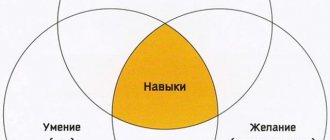More than 20 years ago, Andrei Makarevich prophetically sang about the advent of the “era of great dislike.” I would be glad if someone refutes this thesis, but according to my feelings, this very “dislike” is becoming more and more common in society.
Sociologists talk about times of radical individualism , when the main social value is the possibility of absolutely free self-expression. Absolutely free means not limited by anything. This is not just the freedom to shout to the whole world: “I feel so!”, “I understand so,” but also to demand that others agree with their opinion, regardless of its accuracy, objectivity, ethics, etc.
The nature of emotions
- Intellectualistic approach. Organic manifestations of emotions act as a consequence of mental phenomena.
- Theory I.F. Herbart. The scientist claims that the most important psychological fact is the representation, respectively, of feelings - this is the connection between existing ideas; they can be seen as a reaction to a conflict between ideas.
- Position of V. Wundt. Emotions represent certain changes that characterize the influence of feelings on the course of the ideas themselves.
It pays to be a victim
Supporters of freedom of expression, who are ready to tell the whole world “how they feel,” usually care little about the feelings of the other side, which is supposed to recognize and respect their feelings. And they also keep silent about the fact that simple self-expression (let’s say, throwing out their experiences “into nowhere” to just make them feel better) is usually not enough for them.
A simple two-step manipulation is played out: if you recognized my feelings, then you owe me... (and then a list of demands). And in general, the role of the victim, regardless of whether there are at least some objective grounds for it, is extremely convenient for making others feel guilty and shifting their selfish interests onto their shoulders. In psychotherapy this is called “secondary gain”, just google it for curiosity’s sake.
In fact, it turns out that behind “radical individualism” lies aggressive and manipulative egoism. One of my good friends called this position “centropupism” - when a person not only considers himself, his feelings, opinions and needs, but also demands appropriate recognition from others, not only in words, but also in deeds. But what we end up with is a society where everyone is trying to force/force everyone to “respect me.” Not out of love, but because it will be worse...
Types of Social Emotions
Social emotions are usually divided into positive and negative.
- Positive/conjunctive. Positive social emotions appear when a group of people is aimed at achieving common goals, the result of which brings satisfaction to the participants. Typically, such social emotions can range from weak preference to deep affection. With the latter, exclusively positive intentions are attributed to the partner (in the case of love), which, of course, are often not so objective.
- Negative/disjunctive. Negative social emotions appear when a situation of competition arises: the success of one person entails the failure of another, which often leads to conflict. As a rule, a person can only notice in such an opponent what is unpleasant to him, ignoring his positive qualities.
Consultation for parents “Social feelings: the art of living in society”
Irina Barsukova
Consultation for parents “Social feelings: the art of living in society”
Every parent traditionally pays attention to the development of the child’s mental abilities and tries, first of all, to introduce him to various objects of the surrounding world. When going for a walk with the baby, the mother tries to show and tell the child about trees, birds, and various insects. At home, looking at books, reading fairy tales with beautiful illustrations, he draws attention to fairy-tale characters. Some parents try to teach their child to count to ten as early as three years old, and also introduce them to letters.
The baby learns the rules of behavior by observing the adults around him at home. Parents and older brothers and sisters are the main source for the formation of socially conditioned feelings .
A small child strives with all his might to achieve harmony between his inner world and the outer world.
Building relationships is not an easy task for a child. Learning how to communicate with people begins with mastering external forms of expressing their desires and aspirations. We are talking not so much about actions, but about emotions, the manifestations of which the child observes from the first days of life. First, these are the mother’s emotions towards the baby. A little later, the child is faced with the manifestation of emotions of other adults - both in relation to himself and in relation to each other. Both influence the formation of social feelings
So what are “ social feelings ”
?
Social feelings are not given from birth , they need to be formed from the age of two or three. It is at this age that the formation of self-confidence, pride, shame, conscience, and love for loved ones begins. With the growth of self-awareness, the child is able to experience a sense of duty and responsibility.
How are social emotions ?
Unlike adults, a child has not yet learned to analyze the reasons for his failures - his life experience is too small. However, a four-year-old child is already able to think about why, for example, dad is angry with him, and mom refused to buy ice cream. The conclusions that the baby draws are significantly different from those expected by adults. The child’s logic can lead to the conclusion: “They don’t love me.”
,
“No one needs me,”
etc. Experiencing experiences, the child improves his, still primitive, attempts at self-analysis.
Therefore, parents should not be upset that the child is offended or crying.
He does not yet know how to direct his negative emotion to search for the reasons that led to unsuccessful behavior. When the child learns this, crying and whims will gradually disappear. “The more love a child received in childhood, or rather, the better the parents made him understand that they love him, the more adequate ways they showed their love for the child (it is very important to talk about your love to a child, but this is not enough, the more It will be easier for the child later in life and the more he will achieve.”
R. Campbell
Let's look at the aspects of forming a culture of emotions.
1. Negative emotions. With each manifestation of negative emotions, you should work with your child to figure out why his expectations did not coincide with the result. This must be done tactfully, without in any way infringing on the dignity of the child. An adult and a child are partners who are looking for options to overcome a conflict situation. There are at least two ways out of this situation: leave everything as it is, explaining the reasons for the impossibility of changing the situation, or make changes to the usual settings.
Example:
“Vanya hoped that his mother, as always, would come to pick him up from kindergarten and they would go to the park together. But the grandmother came to pick up the boy and said that his mother was busy and would have to go home straight away. Vanya was very upset, and tears appeared in his eyes. The grandmother, noticing them, thought that her grandson did not want to communicate with her. She began to hurry him up, raising her voice. The boy completely burst into tears.
In the above example, the child’s attitude is “my mother should pick me up”
did not coincide with the real situation. The child is still too young to explain the reason for his grief. In this case, the grandmother should have had a different conversation with her grandson: “Vanya, are you waiting for your mother? Mom, unfortunately, is very busy today; she was given an urgent task at work. She was very upset that she couldn’t go to the park with you today. You will definitely go there tomorrow. Now let’s get ready, go home and wait for mom together. Do you agree?"
By using this or a similar form of communication with a child, an adult can prevent the manifestation of a negative emotion in advance and smooth out its manifestation.
As the child grows up, he should be taught methods of independently searching for reasons why not all of his desires can be fully realized. It is necessary to gradually develop the ability to calmly perceive those situations when you have to temporarily give up even the usual long-awaited pleasures. This is how a person’s ability to control his negative emotions is established in early childhood.
2. Positive emotions. Positive emotions arise when the result exceeds our expectations, that is, life presents some kind of surprise. For example, a child has long dreamed of a gift. But the gift promised by the parents turned out to be better than imagined. Such a pleasant discrepancy between reality and the child’s attitude causes great joy.
It seems that no special education of such emotions is required, because it is so natural to express delight. However, in this case there are some rules. A child who has not been taught ways to show joy and delight may show his joy so strongly that ultimately his actions will be negatively assessed by others.
Note that the power of positive emotions can be quite strong and such emotions also require release. Due to the peculiarities of his development, the child cannot yet independently direct them in a different direction. How to be? Perhaps parents should support their child’s desire to share their joy? After all, it’s always nice to see how the baby is cheerful, smiling and feeling very pleased. But, most likely, the mechanism for directing positive emotions should be the same as for negative ones. That is, having allowed the child to express his joy, it is necessary to talk again about what caused it: “Did you really like the gift? I'm very happy!"
.
Then switch your attention to another activity, that is, direct the energy in a different direction: “Now let’s try to
arrange the toys... ” Once your child understands that you share his
feelings and understand them, he may well occupy himself independently.
Over time, the child will learn to control his emotions, but for now he needs help with this. 3. The appropriateness of the expression of feelings . A small child is self-centered. Therefore, while vigorously expressing his delight, he does not pay attention to the poor health or mood of those around him, believing that everyone around him should feel the same as he does. However, at the age of three to five years, the child develops empathy - the ability to empathize. If in a family parents always treat each other with sensitivity, the child adopts this way of relating to people. True, the ability to empathize does not come by itself. “Grandma is sick, so we’ll try to be quieter today.”
, or:
“Dad had a hard day, let’s not disturb him
.
The child is able to understand, if not the meaning, then the need for a respectful attitude towards the emotions and feelings of others .
Even if your child is not immediately able to express his emotions, taking into account the nature of the situation, however, with the appropriate educational work of adults, their ability to understand the needs and desires of the child, already at four or five years old he can set himself the attitude towards behavior that is most acceptable in a particular situation .
Further reading[edit]
- Economics and psychology are a new promising interdisciplinary direction. Cambridge, MA, MIT Press. 2007. ISBN 978-0-262-06263-3. https://econpapers.repec.org/bookchap/mtptitles/0262062631.htm
- Emotional, regulatory and moral development
. Nancy Eisenberg. https://psych.colorado.edu/~tito/sp03/7536/Eisenberg_2000.pdf - Weiner, Bernard (2006). Social motivation, justice, and moral emotions: An attributional approach. Mahwah, New Jersey [ua]: Lawrence Erlbaum Associates. ISBN 0-8058-5526-2.
| vteEmotions (list) | ||
| Emotions |
| |
| Worldviews |
| |
| Connected |
|
Links[edit]
- Shlomo Hareli; Brian Parkinson. “What is social about social emotions?” (PDF). research.haifa.ac.il
. Retrieved January 6, 2021. - Stephanie Burnett; Geoffrey Bird; Jorge Moll; Chris Frith; Sarah-Jane Blakemore (September 2009). "Development in adolescence of neural processing of social emotions". Journal of Cognitive Neuroscience
.
21
(9): 1736–50. DOI: 10.1162/jocn.2009.21121. PMC 4541723. PMID 18823226. - Lewis, Michael. Shame: The Naked Self
. New York: Free Press;, 1992. 19. Print. - Inhelder, B., & Piaget J. (1958). Development of logical thinking from childhood to adolescence. New York, USA: Basic Books.
- Wainryb, C.; Shaw, Louisiana; Maianu, K. (1998). "Tolerance and Intolerance: Children and Adolescents' Judgments of Dissent, Speech, People and Behavior". Child development
.
69
(6):1541–1555. DOI: 10.1111/j.1467-8624.1998.tb06176.x. - Zahn-Waxler C, Robinson J. 1995. Sympathy and guilt: the early origins of a sense of responsibility. In Self-conscious emotions, ed. J. P. Tangney, K. W. Fischer, pp. 143–73. New York: Guilford
- Stipek, Deborah J; J. Heidi Gralinski; Claire B. Kopp (November 1990). "Development of self-concept in the first years of life." Developmental Psychology
.
26
(6):972–977. DOI: 10.1037/0012-1649.26.6.972. - ^a b Harris, P.L.; Olthof, K.; Tervogt, MM; Hardman, CC (September 1987). "Children's knowledge of situations that evoke emotions." International Journal of Behavioral Development
.
3. 10
(3): 319–343. DOI: 10.1177/016502548701000304. - Cwir, D.; Carr, P.B.; Walton, G.M.; Spencer, S. J. (2011). “Your Heart Makes My Heart Move: Social Connection Cues Induce Shared Emotions and Physiological States Among Strangers.” Journal of Experimental Social Psychology
.
47
(3):661–664. DOI: 10.1016/j.jesp.2011.01.009. - ^ abc Eisenberg, Nancy (February 2000). "Emotions, Rules, and Moral Development". Annual Review of Psychology
.
51
(1):665–697. DOI: 10.1146/annurev.psych.51.1.665. PMID 10751984. - ^ab Sanfey, A.G.; James K. Rilling1; Jessica A. Aronson; Lee E. Nystrom1; Jonathan D. Cohen (June 13, 2003). "The neural basis of economic decision making in the ultimatum game". The science
.
300
(5626): 1755–1758. Bibcode: 2003Sci…300.1755S. DOI: 10.1126/science.1082976. PMID 12805551. - Zeman, J.; Cassano, M.; Perry-Parrish, C.; Stegall, S. (2006). "Emotion regulation in children and adolescents." Journal of Developmental and Behavioral Pediatrics
.
27
(2): 155–168. DOI: 10.1097/00004703-200604000-00014. PMID 16682883. - Elkind, David; Bowen, Robert (1 January 1979). "Imaginary audience behavior in children and adolescents." Developmental Psychology
.
15
(1): 38–44. DOI: 10.1037/0012-1649.15.1.38. - Blakemore, S.J.; den Ouden, H.; Choudhury, S.; Frith, K. (1 June 2007). "Adolescent development of the neural circuitry for thinking about intentions". Social cognitive and affective neuroscience
.
2
(2): 130–139. DOI: 10.1093/scan/nsm009. PMC 1948845. PMID 17710201. - MORIGUCHI, YOSHIYA; OHNISHI, TAKASHI; MORI, TAKEYUKI; MATSUDA, HIROSHI; KOMAKI, GEN (August 1, 2007). "Brain Activity Changes in Neural Substrates for Theory of Mind in Childhood and Adolescence". Psychiatry and Clinical Neurosciences
.
61
(4): 355–363. DOI: 10.1111/j.1440-1819.2007.01687.x. PMID 17610659. - ^ a b Burnett, S; Bird, G; Moll, J; Frith, K; Blakemore, S. J. (September 2009). "Development in adolescence of neural processing of social emotions". Journal of Cognitive Neuroscience
.
21
(9): 1736–50. DOI: 10.1162/jocn.2009.21121. PMC 4541723. PMID 18823226. - ↑
Frith, CD (April 29, 2007).
"Social brain?" . Philosophical Transactions of the Royal Society B: Biological Sciences
.
362
(1480):671–678. DOI: 10.1098/rstb.2006.2003. PMC 1919402. PMID 17255010. - Zahn, R.; Moll, J.; Krueger, F.; Huey, E.D.; Garrido, G.; Grafman, J. (2007, April 10). "Social concepts are represented in the superior anterior temporal cortex". Proceedings of the National Academy of Sciences
.
104
(15):6430–6435. Bibcode: 2007PNAS..104.6430Z. DOI: 10.1073/pnas.0607061104. PMC 1851074. PMID 17404215. - ^ ab McCabe, K. (September 25, 2001). "A functional imaging study of cooperation in reciprocal exchange between two people". Proceedings of the National Academy of Sciences
.
98
(20):11832–11835. Bibcode: 2001PNAS...9811832M. DOI: 10.1073/pnas.211415698. PMC 58817. PMID 11562505. - ↑
Kahneman, Daniel (December 2003).
"Maps of Bounded Rationality: Psychology for Behavioral Economics." American Economic Review
.
93
(5):1449–1475. CiteSeerX 10.1.1.194.6554. DOI: 10.1257/000282803322655392. JSTOR 3132137. - Kahneman, Daniel; Jack L. Knetsch; Richard H. Thaler (Winter 1991). "Anomalies: The Donation Effect, Loss Aversion, and Status Quo Bias". Journal of Economic Perspectives
.
5
(1): 193–206. DOI: 10.1257/jep.5.1.193. JSTOR 1942711. - Ellsberg, Daniel (November 1961). "Risk, ambiguity and wild axioms" (PDF). Quarterly Journal of Economics
.
75
(4):643–669. DOI: 10.2307/1884324. JSTOR 1884324. - Camerer, Colin F. (2003). Experiments in behavioral game theory in strategic interaction
. New York [ua]: Russell Sage [ua] ISBN 978-0-691-09039-9. - Jump up
↑ Eisenberger, N.I. (October 10, 2003).
“Does refusal hurt? An fMRI study of social isolation". The science
.
302
(5643):290–292. Bibcode: 2003Sci…302..290E. DOI: 10.1126/science.1089134. PMID 14551436. - O'Doherty, J. (16 April 2004). "Dissociative roles of the ventral and dorsal striatum in instrumental conditioning". The science
.
304
(5669):452–454. Bibcode: 2004Sci…304..452O. DOI: 10.1126/science.1094285. HDL: 21.11116/0000-0001-A0A8-C. PMID 15087550. - de Quervain, DJ-F. (August 27, 2004). "The neural basis of altruistic punishment". The science
.
305
(5688):1254–1258. Bibcode: 2004Sci…305.1254D. DOI: 10.1126/science.1100735. PMID 15333831. - Ferguson TJ, Stegge H. 1998. Measuring guilt in children: A rose by any other name still has thorns. In Wine and Children, ed. J. Bybee, pp. 19–74. San Diego: Academic
- ^ ab Tangney, June P. (1 January 1991). "Moral Affect: The Good, the Bad, and the Ugly." Journal of Personality and Social Psychology
.
61
(4):598–607. DOI: 10.1037/0022-3514.61.4.598. PMID 1960652. - Eisenberg, Nancy; Fabes, Richard A.; Murphy, Bridget; Carbone, Mariss; and others. (January 1, 1994). "The relationship of emotionality and regulation to dispositional and situational responses associated with empathy." Journal of Personality and Social Psychology
.
66
(4):776–797. DOI: 10.1037/0022-3514.66.4.776. - Weiner, Bernard (2006). Social motivation, justice, and moral emotions: An attributional approach
. Mahwah, New Jersey [ua]: Lawrence Erlbaum Associates. ISBN 978-0-8058-5526-5. - Jump up
↑ Weiner, Bernard (January 1, 1985).
"An attributional theory of achievement motivation and emotion". Psychological Review
.
92
(4):548–573. DOI: 10.1037/0033-295X.92.4.548. PMID 3903815. - Weiner, Bernard; Perry, Raymond P.; Magnusson, Jamie (1 January 1988). “Attributional analysis of reactions to stigmas.” Journal of Personality and Social Psychology
.
55
(5):738–748. DOI: 10.1037/0022-3514.55.5.738.
The meaning of past experience
Details and information about the past are used to make decisions because past experiences of feelings influence present decision making. It also determines how people will feel in the future. Gilbert and Wilson conducted a study to show how well a person would feel if they bought flowers for themselves for a specific reason (birthday, anniversary or promotion, etc.). People who had no experience of buying flowers for themselves and those who did buy flowers were interviewed. The results showed that those who had purchased flowers in the past for themselves felt happier, and that feeling lasted longer for them than those who had never purchased flowers for themselves.











